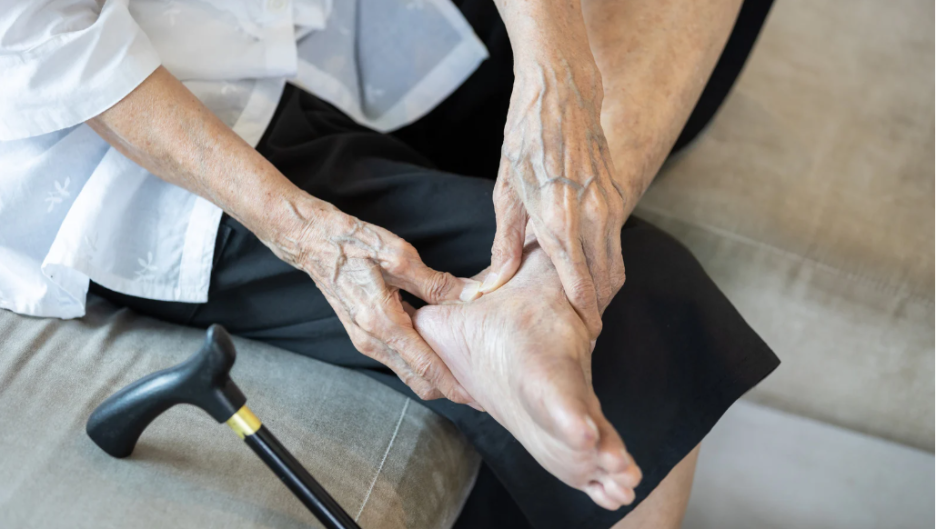As we grow older, our bodies inevitably change and our feet are no exception. Years of use, underlying health conditions, and reduced circulation can lead to a variety of foot problems that cause discomfort, limit mobility, and increase the risk of falls. Understanding what common foot problems in older adults are is essential for maintaining independence, managing pain, and avoiding serious complications.
In this guide, we’ll explore the most prevalent foot issues among seniors, the warning signs to look out for, and how proactive foot care both at home and with a podiatrist can make a life-changing difference.
Why Senior Foot Health Deserves Special Attention
Foot health often goes overlooked, but for older adults, even minor issues can escalate quickly. Decreased fat padding, thinning skin, weakened circulation, and a higher likelihood of chronic conditions (like diabetes or arthritis) make the feet more vulnerable with age. These changes can lead to:
- Pain while walking or standing
- Poor balance or increased fall risk
- Slow-healing wounds or ulcers
- Loss of sensation or tingling
- Difficulty trimming nails or caring for feet
That's why understanding what common foot problems in older adults are and seeking early treatment is not just about comfort, it’s about preserving overall well-being and independence.
Common Foot Conditions in Older Adults
1. Bunions
Bunions are bony bumps that form at the base of the big toe, often caused by years of pressure or tight-fitting shoes. In seniors, bunions can lead to joint stiffness, pain, and difficulty walking.
How to manage:
- Choose wide-toe shoes with supportive soles
- Use bunion pads or toe spacers
- Consult a podiatrist for assessment or possible surgery
2. Hammertoes
A hammertoe is a toe that bends abnormally at the middle joint, often affecting the second, third, or fourth toes. It’s a common issue in seniors due to weakened muscles and tendon imbalances.
Signs to watch for:
- Bent toes that don’t straighten
- Corns or calluses on the affected toe
- Pain when wearing shoes
3. Arthritis
Both osteoarthritis and rheumatoid arthritis frequently affect the small joints of the feet. Symptoms include joint pain, swelling, stiffness, and difficulty walking.
Treatment options:
- Anti-inflammatory medications
- Foot braces or orthotics
- Stretching exercises and physical therapy
4. Fungal Infections
Fungal nail infections (onychomycosis) and athlete’s foot are especially common in seniors due to weakened immune systems and moisture buildup around the feet.
Preventive care:
- Keep feet clean and dry
- Use antifungal sprays or creams
- Wear moisture-wicking socks and breathable footwear
5. Diabetic Foot Complications
Diabetes can lead to poor circulation and nerve damage (neuropathy), making the feet vulnerable to wounds, ulcers, and infections that don’t heal properly.
Early signs of trouble include:
- Numbness or tingling
- Cuts or blisters that go unnoticed
- Skin discoloration or swelling
If you or a loved one is managing diabetes, routine foot checks are essential. For a deeper dive into this topic, read our blog: Mobile Podiatrist for the Elderly: Convenient In-Home Foot Care for Seniors. It outlines how personalized, at-home care can help seniors avoid severe diabetic foot complications.

Warning Signs That Shouldn’t Be Ignored
No matter the cause, certain foot symptoms in older adults require prompt medical attention. Contact a podiatrist if you notice:
- Persistent pain or swelling
- Sores or wounds that don’t heal
- Foul odor or discharge
- Changes in skin color or temperature
- Toenail thickening or discoloration
- Difficulty walking or standing
Ignoring these signs can lead to infections, mobility loss, or even hospitalization.
Proactive Foot Care Tips for Aging Feet
Good foot hygiene and early intervention go a long way in preventing complications. Here are some daily habits to protect your feet as you age:
- Wash and dry your feet thoroughly especially between toes
- Moisturize dry or cracked skin
- Inspect your feet daily for cuts, blisters, or changes
- Trim toenails straight across
- Avoid going barefoot to prevent injury
- Wear comfortable, supportive footwear that fits properly
Many older adults benefit from assistance with foot care, especially if bending over is difficult. If needed, a mobile podiatrist can bring professional help directly to your home.
How a Podiatrist Can Help Seniors Stay on Their Feet
A podiatrist trained in senior care understands the specific challenges of aging feet. They can:
- Diagnose and treat foot deformities
- Manage chronic conditions like arthritis or diabetes
- Recommend custom orthotics or therapeutic shoes
- Trim nails safely and treat fungal infections
- Provide wound care and preventive screenings
Even better, many podiatrists now offer in-home visits, ensuring that even those with limited mobility can receive expert care without the stress of travel.
When to Consider a Mobile Podiatrist
For seniors who rely on a caregiver, use a wheelchair, or find transportation difficult, mobile podiatry services are a game changer. These providers come equipped with the tools and training to deliver comprehensive foot care in the comfort of home.
By choosing a mobile provider, you get:
- Convenience and comfort
- Reduced fall risk from travel
- Ongoing care tailored to your health history
- Peace of mind for family and caregivers
To find out if this service is right for you, schedule an appointment with our mobile podiatry team today. We bring compassionate, expert care directly to you—wherever you are.
Final Thoughts: Why Foot Care Should Be a Priority in Older Age
Knowing what common foot problems in older adults are empowers seniors and caregivers to take proactive steps toward better health. Whether it’s managing bunions, monitoring diabetic complications, or simply keeping toenails healthy, consistent care makes all the difference.
Investing in foot health means protecting your independence, reducing fall risk, and enjoying a higher quality of life as you age.






